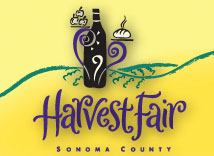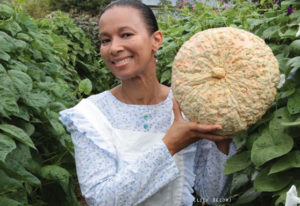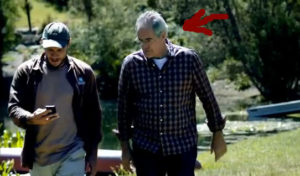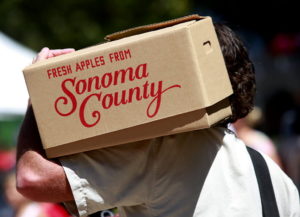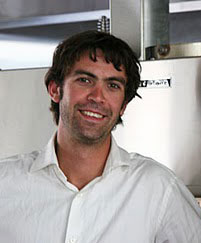
Hesitation has no place at the slaughter. The kill must be quick, the hand swift and the mind resolved. Nervously lifting my condemned pig off the back of Sonoma rancher Nancy Prebilich’s pickup truck, I feel none of these things. The 50-pound black and white Hampshire prances and sniffs from inside his metal cage unaware that the handful of clover we’ve tossed inside will be its last meal.
“Do you want to do it?” asks Prebilich, pointing to a .22 rifle. She knows I’m ambivalent. Firearms aren’t in my repertoire, and we agreed earlier it wouldn’t be fair to the animal should my aim and inexperience falter. I’m sure the wane look on my face confirms the choice. But it feels like a failure on my part not to do the deed I’d promised to do six weeks ago when this adventure began.
In August, I purchased a piglet from Gleason Ranch with plans to raise, kill and eat it. The idea was simply get to know my meat—to break down the walls most carnivores prefer never to look behind. But the process isn’t without peril. Few ranchers are willing to publicly open their barn doors to the process of harvesting animals, and even fewer of us really want to know that our bacon had a face. Learning of my intentions, several local vegans vocally plead for the life of my first pig (which we’d named Reggie Bacon), ultimately securing my consent and the resources to send him to a no-kill farm sanctuary in Orland. Their compassionate perspectives on meat-eating became an integral part of the story, strengthening my resolve as a carnivore to stop taking my pork chops for granted.
So, in late September, another pig from Reggie Bacon’s litter was purchased without chance of reprieve. After wrestling the squirming, muscular creature into a cage and driving through rural West County to a backyard processing facility, his moment had finally arrived. Heart-racing, I feel queasy and unsure about the inevitable process about to unfold.
Lost in my own dread, however, it happened. There is no place for my hesitation here, and the trigger is pulled. With a ping that sounded more like a BB gun than a rifle, the bullet hits its mark. The pig’s legs instantly buckle and it collapses. Brain function has ceased. We’ve called upon a more seasoned butcher at the facility to grab the animal from its cage and quickly cut the jugular vein. He has a deft assuredness a butcher who knows every inch of the animal’s anatomy. Kneeling, he makes a single cut and blood pumps from the neck, a necessary step to keep the meat from spoiling. As it blooms onto the wet concrete, my hand instinctively lifts to cover my mouth, my eyes widen. The animal continues to have jolting, reflexive movements for several minutes. I won’t pretend it isn’t shocking to watch. I am grateful when it is over.
 The roar of a propane-fueled torch explodes the silence. The carcass is lifted onto a hook, and from here the process becomes more scientific than emotional. We lower the pig into heated water using a motorized hoist. The torch heats the water in moments, and after about 90 seconds, we remove the pig only to discover we’ve accidentally boiled the creature. It then becomes an arduous process of rubbing, shaving and scraping to remove the hair and we give up more than once. I remove the toenails as a distraction. But in the September heat, there’s no time for wasting as flies gather around the head.
The roar of a propane-fueled torch explodes the silence. The carcass is lifted onto a hook, and from here the process becomes more scientific than emotional. We lower the pig into heated water using a motorized hoist. The torch heats the water in moments, and after about 90 seconds, we remove the pig only to discover we’ve accidentally boiled the creature. It then becomes an arduous process of rubbing, shaving and scraping to remove the hair and we give up more than once. I remove the toenails as a distraction. But in the September heat, there’s no time for wasting as flies gather around the head.
Removing the internal organs is the next step, and it is a remarkably delicate process. If the knife nicks the spleen or intestines, the meat will be ruined. With a few quick flicks of a razor sharp blade, the skin gives way. It is a live biology lesson to see the kidney, liver, heart, lungs and stomach emerge and we remove them in a bloodless, blue-grey mass. Handling the carcass is intensely intimate. I am aware that this is no pork chop, but an animal that minutes ago was alive. I spend a long minute touching the ears and long eyelashes, pressing the soft cartilage of the nose curiously.
We constantly spray the pig with water to keep eager flies away. Bees swarm around a bucket filled with the internal organs we won’t use (in this case, the stomach, spleen and intestines). This is hot, messy and difficult work. It is easy to see why efficient and sanitary facilities are necessary for commercial meat processing and appreciate the strength of our ancestors, for whom this was a frequent task. Though the pig is for personal consumption (hence why we’re not at a USDA-regulated facility required for commercial processing), we’re all a little worried about getting the pig on ice. After a final spray down, a thorough cleaning of the ears and a last pass of the razor, we lift the carcass into an ice chest, placing with it a chicken and rabbit that we’ve also harvested. I’ve nicked the spleen on both, confirming that my butchering skills still need considerable work.
 Several days later, all of the animals are broken down into smaller pieces at a butchering demonstration. A crowd gathers to watch as chefs wield huge knives, dissecting the animals into more familiar dinner-sized pieces. Here is a loin, ribs, a leg for ham. Faces range from enraptured to disgust. That is exactly the point. Our audience is getting personal with their food as well.
Several days later, all of the animals are broken down into smaller pieces at a butchering demonstration. A crowd gathers to watch as chefs wield huge knives, dissecting the animals into more familiar dinner-sized pieces. Here is a loin, ribs, a leg for ham. Faces range from enraptured to disgust. That is exactly the point. Our audience is getting personal with their food as well.
A heavy plastic tub holds the remaining pieces, and our pig becomes a communal feast. The cheeks and ears are wrapped around the belly to create a porchetta di testa; the legs will be smoked to become hams. Shoulders are brined and slow cooked. A chef friend boils the head to make a gelatinous head cheese, and the ribs somehow disappear after the event (though no doubt ending up on someone’s grill). Nothing is wasted, nothing pushed aside uneaten.
But this pig is not an easy meal for me. With every bite, I’m reminded of the process, making my tongue feel rubbery and my mouth dry. The meat is leaner, less manufactured, a hint gamier. The loin of the young pig is barely longer than my index finger—not the arm-length piece of meat you’d get at the store. The skin I’ve crisped in the oven has a few hairs, and is slightly burnt. It’s not perfect, but as I chew, I am again grateful. I can say without hesitation that I’ve gotten personal with my dinner, looked it straight in the eye and taken part in bringing it to the table. Can you?
Previously:
– Getting to Know Reggie Bacon (Part 1)
– A Reprieve for Reggie (Part 2)



